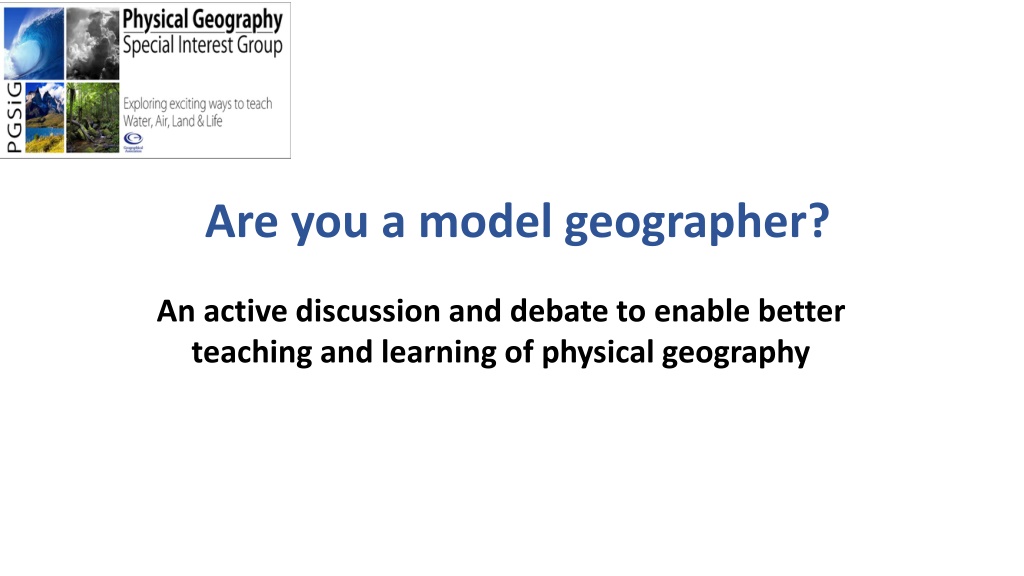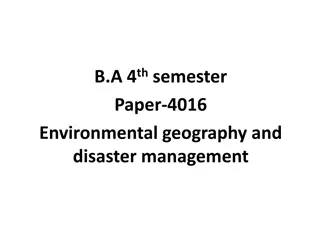Exploring Physical Geography Models and Theories
Engage in an active discussion concerning the teaching and learning of physical geography, focusing on various models, including the Bradshaw model. Learn about the importance and usage of models in physical geography education, their impact on student learning, and the essence of models in teaching practices.
Download Presentation

Please find below an Image/Link to download the presentation.
The content on the website is provided AS IS for your information and personal use only. It may not be sold, licensed, or shared on other websites without obtaining consent from the author. Download presentation by click this link. If you encounter any issues during the download, it is possible that the publisher has removed the file from their server.
E N D
Presentation Transcript
Are you a model geographer? An active discussion and debate to enable better teaching and learning of physical geography
Are you a model geographer? What course (of the river) is this - and why? Which course (of the river) is this - and why?
Are you a model geographer? Some starter questions answer individually 1. What models do you teach in physical geography lessons? (Make a list of an many as you can think of) 2. How do you use models in teaching physical geography? (start/middle/end of topic?, before/after a case study?) 3. What do you think students learn from the models you teach? 4. Can you teach physical geography without using models? 5. What makes a model (for use in teaching) powerful?
Are you a model geographer? Some starter questions share answers 1. What models do you teach in physical geography lessons? (Make a list of an many as you can think of) 2. How do you use models in teaching physical geography? (start/middle/end of topic?, before/after a case study?) 3. What do you think students learn from the models you teach? 4. Can you teach physical geography without using models? 5. What makes a model (for use in teaching) powerful?
Are you a model geographer? What is a model? Concrete Conceptual an analogue of the real world e.g. a stream table a simplified representation an abstraction of reality a scientific way to highlight relations and interactions in a system Educational descriptive explanatory predictive Diagram source: USGS . Public domain https://i0.wp.com/eos.org/wp- content/uploads/2022/10/usgs- water-cycle.png?ssl=1
Are you a model geographer? The Bradshaw model Who was Bradshaw? What is assumed about the origin of this model?
Are you a model geographer? The Bradshaw model .. first appears as an illustration in M J Bradshaw's 1978 A level textbook The Earth's Changing Surface . Bradshaw's illustration is a simplification of Stanley Schumm s simplified river model which had been published a year earlier in The Fluvial System , although aspects of the model had already appeared in a series of academic papers over the previous 10 years. Schumm based his model on an empirical analysis of a variety of North American rivers, and suggested that it could be used to predict how any given river channel would respond to changes in discharge or sediment supply caused by river engineering, such as a dam or flood relief channel. What are the implications for teaching this model?
Are you a model geographer? What are the assumptions in this model? What are the merits of this model?
Are you a model geographer? My investigation was to measure the downstream fluvial changes of the river Harbourne and compare them to the Bradshaw model. My investigation greatly improved my understanding of the fluvial changes of a river as all my hypotheses were proved correct; therefore my investigation was a success. Student: A level Independent investigation What are the dangers of this model?
Are you a model geographer? My investigation was to measure the downstream fluvial changes of the river Harbourne and compare them to the Bradshaw model. My investigation greatly improved my understanding of the fluvial changes of a river as all my hypotheses were proved correct; therefore my investigation was a success. Student A level Independent investigation What are the dangers of this model (to this student)? A misconception that geography students must overcome is that a model is the same as the reality it represents Forcing the fit - there is an ambition to predict which means the results must fit the model Students interpret the world in a way that fits the model rather than interpreting the model in a way that fits the world. The models leads students into thinking the world is static and fixed it always works this way The tyrrany of models (Prof Stephen Trudgill)
Are you a model geographer? Source: Boris D. CreativeCommons https://commons.wikimedia.org/wiki/File:Yosemite_falls1.jpg Source: Maurice D Budden www.geograph.ie/photo/2966965 What (model) do you teach about (the formation of) waterfalls?
Are you a model geographer? Source: Maurice D Budden www.geograph.ie/photo/2966965 Bridal Falls, Yosemite, USA The rock is all granite no hard/soft rock differentiation. Another explanation is needed The rock is all slate no hard./soft rock differentiation. Another explanation is needed. Source: Boris D. CreativeCommons https://commons.wikimedia.org/wiki/File:Yosemite_falls1.jpg The Model: Speke Beck, North Devon. England Here s the textbook recipe to create a waterfall: 1.Take bands of hard and soft rock, 2.erode the soft rock carefully for a period of time until the hard rock is undercut, 3.the hard rock collapses, 4.a plunge pool is created, 5.the waterfall retreats to form a gorge. Happy ending to such stories the model works Simple, comfortable and seductive BUT . look at the geographical conditions in these examples . the same outcome is possible from range of processes (= equifinality) the story doesn t always fit until bigger significance is found.
Are you a model geographer? Five classes of waterfalls are commonly recognised: 1. resulting from differential erosion of rocks with varying resistance, 2. caused by tectonic uplift/ displacements in the longitudinal profile 3. caused by glacial scour lowering the base- level of rivers and the longitudinal profile 4. resulting from changes in sea-level shifting the base-level of rivers and the longitudinal profile 5. caused by climate-generated increase in vertical erosion power. The significant meaning (powerful knowledge) beyond the single descriptive model . What do waterfalls tell us about the changing earth? changes in base (sea) level? tectonics? environmental change over time?
Are you a model geographer? Thinking like a physical geographer - the geo-scientific methods of T.C. Chamberlin (1890) 1. Ruling Theory: 1. Ruling Theory: The "method of the ruling theory" begins with a ready answer to which the thinker grows attached, looking only for facts that confirm the answer. 2. 2.Working Hypothesis: Working Hypothesis: The "method of the working hypothesis is the textbook version of (geo)science. But Chamberlin observed ". that a working hypothesis may with the utmost ease degenerate into a ruling theory e.g. the hypothesis of mantle plumes creating (simple) circular convection cells must cause plate movement. Plate tectonics is a working hypothesis - being extended today with a more critical awareness of its uncertaintiesand alternative mechanisms of plate movement
Are you a model geographer? Thinking like a physical geographer in geographical enquiry and modelling Using the method of multiple working hypotheses starts with many tentative solutions or explanations (suggestions/imagination) expectation that no single answer may provide the full explanation attempts to find the best fit explanation through abductive reasoning Chamberlin s example = origin of the North American Great Lakes - Rivers? (judged from topographic evidence) - Glacial erosion? - Warping of the crust? (isostatic bending) - Other possible factors (e.g. structural weakness)?
Are you a model geographer? Role of Models Developing Understanding Simplification (of complexity) Explore relationships Enable wholisitic view Enables logical thinking (if this then that) Affords a way of predicting (if this then that) Based on asssumptions Misrepresenting Out-of-date (based on old evidence/thinking) Forced to fit (ruling prediction vs real results) Based on misconceptions
Are you a model geographer? Role of Models Testing/Observing the geographical conditions Critical thinking Real (naughty) world vs the ideal or type world Whose model is it? (Type 3 Powerful Knowledge) How old is the model? Where was it formulated? How was this physical geography explained before? Start with simple Promoting progression Revisit to add in more layers to a model (and as a diagnostic tool) Identify more probing enquiry questions about the model (or its component parts) RBuild in explicative use rather than descriptive approach
Are you a model geographer? Are you a model geographer? Reading place in physical geography Recognizing that every location is potentially unique does not render generalizations meaningless. Regularities in time and space can still be observed as repeated patterns of landforms, and interpretations of these patterns can support efforts to meaningfully transfer understandings from one location to another. The challenge lies in identifying where a general pattern holds true and how and when local differences may be important. Theory (general understanding) informs local interpretations, but site-specific appraisals prompt insights into differences , allowing local stories to emerge. p. 62 in: Brierley, G., Fryirs, K., Cullum, C., Tadaki, M., He, Q. H., & Blue, B. (2013). Reading the landscape: integrating the theory and practice of geomorphology to develop place-based understandings of river systems. Progress in Physical Geography, 37, 601 621.
Are you a model geographer? How to be a model geography teacher? 1. Clarify (make explicit) when teaching (using) a model 2. Explain the model is not reality it is a a simplification/generalisation 3. Ask/explore (with students) - what are the assumptions of the model? 4. Ask/explore - what are the merits of the model? 5. Ask/explore what are the limitations of this model? 6. Beware the danger of forcing the fit. 7. Stress models are provisional and dynamic. 8. Use as a tool to overcome cognitive conflict = treat as a developmental/dynamic tool. (present/elicit idea/model observe reality/evidence update model)
Are you a model geographer? How to be a model geography teacher? What will you do next? What will you take back to your classroom and department? How will your students benefit from you being a model geography teacher? Diagram source: USGS . Public domain https://i0.wp.com/eos.org/wp- content/uploads/2022/10/usgs- water-cycle.png?ssl=1
Are you a model geographer? https://teachingphysicalgeog.wordpress.com/























